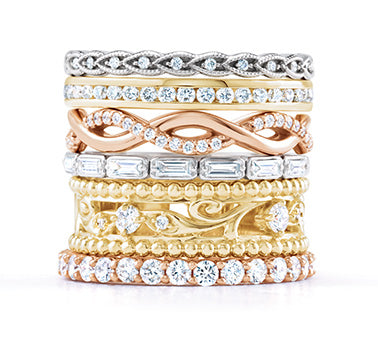Lifetime Warranty
24/7 Hour Customer Service
Free Shipping
30-Day Return
Moijey Fine Jewelry & Diamonds Blog
Spinel: One Species, Many Colors
Originally written on August 3rd, 2017
Updated April 10th, 2020
Last week, I briefly presented spinel, a new birthstone for August, and another alternative center stone for an engagement ring (see our engagement page on Moijey for inspiration). Spinel, in the gem and jewelry industry, is an underappreciated gemstone. It used to be mistaken for other gems, the primary example being ruby.


Mistaking red spinel for ruby was a common occurrence in history until 1783, when Jean Baptiste Louis Rome de Lisle, a mineralogist, discovered that spinel was a different mineral species from ruby. Many people credit the distinctions between ruby and spinel as the birth of gemology.
It was easy to believe that ruby and red spinel were the same gems. Like rubies, red (and pink - see our earrings) spinel fluoresces under sunlight, due to the trace element chromium. Oddly enough, the red spinel is more rare and valuable than the most excellent ruby and challenging to find in high quality. Throughout history, some of the most famous gemstones were thought to be rubies but turned out the be red spinel.

The Black Prince's "Ruby," one of England's crown jewels, is one of the most famous examples of mistaken gem identity. Located in the Tower of London, this 170-carat gemstone is set in the in the British Imperial Crown and has a small ruby cabochon set into the stone itself. You read that correctly, a ruby cabochon set into a spinel gemstone. This is because the Black Prince used to be strung on a necklace. In history, it wasn't always red spinel. For centuries, people thought the Black Prince was a ruby, hence the title.
The Black Prince part of the title came to be in 1387 when Edward, Prince of Wales - also known as the "Black Prince" from the black armor he wore into battle - received the gem as payment for a battle victory. It has remained in the royal family since, and it has a wide variety of disasters, from WWII bombing raids to attempted thefts and fires. Here is an up-close picture of the Black Prince's "Ruby" from the British Imperial Crown.

In my last article, I said that spinel in its purest form is colorless. It is because of trace elements in spinel's cubic crystal structure that they form in all kinds of beautiful and crisp colors. Aside from red and pink, spinel is available in different varieties of violets, blues, purples, and oranges.

Orange and purple spinel obtain their colors from a mixture of chromium and iron, violet, and blue spinels owe their color to traces of iron, and vibrant blue spinel has its bright color from cobalt. On the left, there are beautiful examples of blue and purple spinel from the Smithsonian Natural History Museum in Washington, DC.
Spinel that is opaque with iron in its composition is black spinel or chrome spinel—our Black Spinel Fleur-De-Lis Necklace.



In 2002, miners discovered a deposit of bright neon pink spinel in Myanmar, the source of some of the most beautiful spinel gemstones. The gems were affectionately called Jedi Spinels because Star Wars: Episode II – Attack of the Clones was in theaters that the time. Also, Vincent Pardieu, the author of the article where I learned about this particular pink spinel and the supervisor of field gemology for GIA, had to be careful when he was examining quality spinel rough. Dark tones or "the dark side" of a gem decreased its value. If you, your significant other, or both of you are Star Wars fans, pop the question with one of our engagement rings, like our bezel set bypass engagement ring mounting, from Moijey. We can find for you a beautiful spinel gemstone, similar in color to this picture of rough from the GIA website.

Not only does spinel come from Myanmar (formerly Burma), but it comes from Tanzania, Tajikistan, Sri Lanka, and Vietnam. I hope spinel gets more attention outside the gem and jewelry industry because it is a crisp and vibrant gemstone. Let's not forget the August babies who now have more than one color to choose from besides the summery green of peridot, which we will visit next week.
Thank you for stopping by Moijey. We hope to see you soon.
Spinel: One Species, Many Colors
Originally written on August 3rd, 2017
Updated April 10th, 2020
Last week, I briefly presented spinel, a new birthstone for August, and another alternative center stone for an engagement ring (see our engagement page on Moijey for inspiration). Spinel, in the gem and jewelry industry, is an underappreciated gemstone. It used to be mistaken for other gems, the primary example being ruby.


Mistaking red spinel for ruby was a common occurrence in history until 1783, when Jean Baptiste Louis Rome de Lisle, a mineralogist, discovered that spinel was a different mineral species from ruby. Many people credit the distinctions between ruby and spinel as the birth of gemology.
It was easy to believe that ruby and red spinel were the same gems. Like rubies, red (and pink - see our earrings) spinel fluoresces under sunlight, due to the trace element chromium. Oddly enough, the red spinel is more rare and valuable than the most excellent ruby and challenging to find in high quality. Throughout history, some of the most famous gemstones were thought to be rubies but turned out the be red spinel.

The Black Prince's "Ruby," one of England's crown jewels, is one of the most famous examples of mistaken gem identity. Located in the Tower of London, this 170-carat gemstone is set in the in the British Imperial Crown and has a small ruby cabochon set into the stone itself. You read that correctly, a ruby cabochon set into a spinel gemstone. This is because the Black Prince used to be strung on a necklace. In history, it wasn't always red spinel. For centuries, people thought the Black Prince was a ruby, hence the title.
The Black Prince part of the title came to be in 1387 when Edward, Prince of Wales - also known as the "Black Prince" from the black armor he wore into battle - received the gem as payment for a battle victory. It has remained in the royal family since, and it has a wide variety of disasters, from WWII bombing raids to attempted thefts and fires. Here is an up-close picture of the Black Prince's "Ruby" from the British Imperial Crown.

In my last article, I said that spinel in its purest form is colorless. It is because of trace elements in spinel's cubic crystal structure that they form in all kinds of beautiful and crisp colors. Aside from red and pink, spinel is available in different varieties of violets, blues, purples, and oranges.

Orange and purple spinel obtain their colors from a mixture of chromium and iron, violet, and blue spinels owe their color to traces of iron, and vibrant blue spinel has its bright color from cobalt. On the left, there are beautiful examples of blue and purple spinel from the Smithsonian Natural History Museum in Washington, DC.
Spinel that is opaque with iron in its composition is black spinel or chrome spinel—our Black Spinel Fleur-De-Lis Necklace.



In 2002, miners discovered a deposit of bright neon pink spinel in Myanmar, the source of some of the most beautiful spinel gemstones. The gems were affectionately called Jedi Spinels because Star Wars: Episode II – Attack of the Clones was in theaters that the time. Also, Vincent Pardieu, the author of the article where I learned about this particular pink spinel and the supervisor of field gemology for GIA, had to be careful when he was examining quality spinel rough. Dark tones or "the dark side" of a gem decreased its value. If you, your significant other, or both of you are Star Wars fans, pop the question with one of our engagement rings, like our bezel set bypass engagement ring mounting, from Moijey. We can find for you a beautiful spinel gemstone, similar in color to this picture of rough from the GIA website.

Not only does spinel come from Myanmar (formerly Burma), but it comes from Tanzania, Tajikistan, Sri Lanka, and Vietnam. I hope spinel gets more attention outside the gem and jewelry industry because it is a crisp and vibrant gemstone. Let's not forget the August babies who now have more than one color to choose from besides the summery green of peridot, which we will visit next week.
Thank you for stopping by Moijey. We hope to see you soon.






